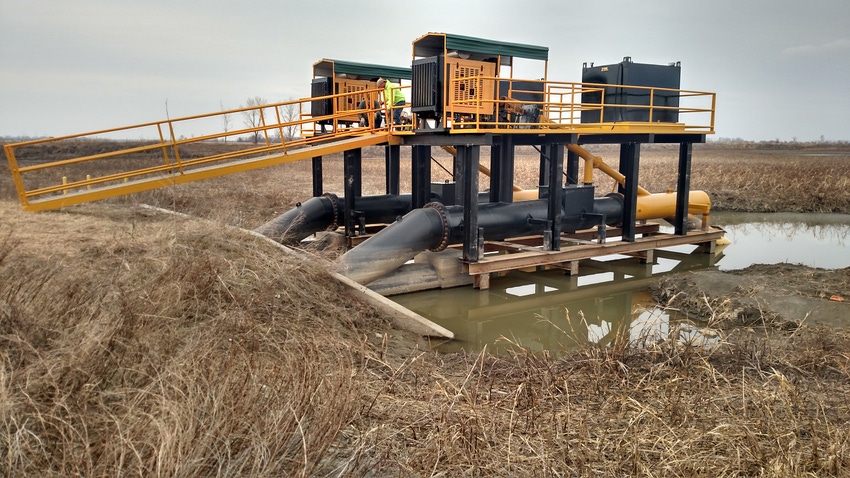
As a company building and selling water pumps, Hoxie, Ark.-based Water Hog has been successful for years. But Water Hog – which uses screw-type systems that go through levees instead of over them -- has hardly been static.
“At the start, we weren’t really sure of the best way to design these,” says owner Rick Spargo. “We’ve been fine-tuning and tweaking things ever since. There are folks now that want to move heavy amounts of water and so we’ve had to develop super-heavy duty machines.”
Since the move, “we don’t have any more problems with our pumps. The problems are operator issues – someone might light grease the pump or run it out of water.”
Lately, Water Hog has moved to automating the pumping systems. Pumps can now be operated by smart phones and the like.
While Water Hog still emphasizes the agricultural use of its products, the company has also moved into assisting municipalities and potential flood zones. “We’re working with Wilson, Ark., a town that’s close to us. We’ll set up a system for them because they want to drain water that’s a breeding ground for mosquitoes. The pump will solve their issues and it’ll be fully automated – you just have to make sure there’s enough fuel.
“We’ve already been up on the Nebraska/Iowa line working on several projects there with the Army Corps of Engineers. This was the first time the Corps has ever let anyone go through the levees. After we got the okay and got the pump running, they were at a point where they had to close the gate in the middle and begin pumping.”
The riverside water “was trying to come in so they were pumping against the head pressure. Well, when they did that, one day they forgot to shut the center tube and the water was equal on both sides. They fired the pumps up and, when they did, they began to draw on the center pipe. The velocity of the pumps pushing out into the river started making that center tube build that much suction. It was almost like having a third pump added to the mix.”
The Corps workers “weren’t expecting that and say the pumps have proven a massive new way to move water. They seem tickled to death about what these pumps can accomplish.”
Flooding events have become common along U.S. river systems and Spargo says Water Hog offers solutions that many are unaware exist. “Think about all the crops, the houses, the towns, that go under water when the river gets too high.”
Common wisdom
Common wisdom is that floodwater should be removed and pumped over the levee and dumped into the river. Spargo insists that’s the wrong approach. “There’s very little you can do because water can’t be moved quickly, or efficiently, enough if you’re pumping over the levee. That just isn’t going to happen. You simply have to go through the levees. We’ve been working on this for 15 years, been through some of the toughest challenges, and I can tell you it’s the only way to go if you want to actually fix the problems.
“Where we have these super floods, (government officials) come in and set pumps off the top of the levees. Just one of our pumps will do the work of six to eight of the pumps they put up. We just push the water straight through. It isn’t that other people don’t know that – but they don’t know the technology has caught up.”
Savings
As for agriculture, Spargo has “worked with a north Missouri farmer whose land always seems to flood. He drew money off insurance but hardly enough to mess with. Now, after installing a pumping system, he says the pump pays for itself every year.
“Think about how much money we’re losing. If you have a pump that does the job, the country would save incredible amounts of money on flood insurance, on crop insurance. Think how much money would be saved by the taxpayers.
“Having a pump on your land should be just like having a fire extinguisher in your home. If you have to have one in your home to be insured why don't you have to have a little protection on your crop to get insurance? At the very least, farms that have one of our pumps should be able to get lower rates. Over the last 15 years, our pumps have been helping farms save millions of dollars.”
Water Hog is now on the FEMA list of approved vendors. The company recently got a GSA Schedule Contract, a vehicle used to sell products to the U.S. government.
Water Hog pumps now need to reach an audience of government agencies. “Nobody knows we’re out here or what we’re capable of. The pumps’ abilities speak for themselves -- we’ve just got to get in front of the right people.”
Working with the Arkansas Game and Fish Commission, Spargo and colleagues have pumped up Lake Ashbaugh for years. The pump adds over 8 feet of water to the 525-acre lake in 48 days, or less, using 1.19 gallons of fuel per 325,900 gallons of water.
“This year, we’ve already pumped that lake up. It normally takes regular pumps months to pump that much water over the levee. We did it in 30 days.”
About the Author(s)
You May Also Like




